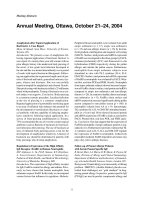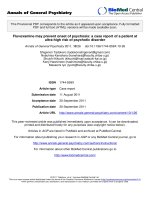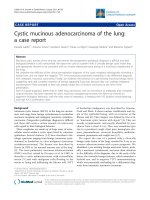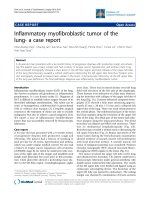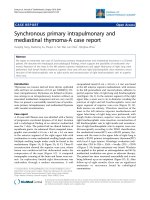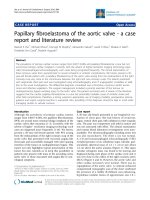Báo cáo y học: " Orocervical foetus-in-foetu with prenatal sonographic diagnosis: a case report" doc
Bạn đang xem bản rút gọn của tài liệu. Xem và tải ngay bản đầy đủ của tài liệu tại đây (357.29 KB, 4 trang )
BioMed Central
Page 1 of 4
(page number not for citation purposes)
Journal of Medical Case Reports
Open Access
Case report
Orocervical foetus-in-foetu with prenatal sonographic diagnosis: a
case report
Kolawole T Braimoh
1
, Adekunle Y Abdulkadir*
1
and Rabiu O Balogun
2
Address:
1
Department of Radiology, University of Ilorin Teaching Hospital, P.M.B. 1459, Ilorin, Kwara State, Nigeria and
2
Department of
Obstetrics and Gynaecology, University of Ilorin Teaching Hospital, P.M.B. 1459, Ilorin, Kwara State, Nigeria
Email: Kolawole T Braimoh - ; Adekunle Y Abdulkadir* - ;
Rabiu O Balogun -
* Corresponding author
Abstract
Introduction: Foetus-in-foetu is a very rare congenital abnormality where a malformed foetus is
included within the body of another foetus. Less than 200 cases have been reported with over 80%
occurring in the abdomen. Only three cases of cervical foetus in foetu have been reported. The
present case of giant orocervical foetus-in-foetu appears to be an index case.
Case presentation: This is a report of an extremely rare orocervical foetus-in-foetu with
grotesque oddity diagnosed on prenatal ultrasonography at 35 weeks gestational age in a 28-year-
old, G2P1+0, Nigerian woman who was unsure of her last menstrual date or month. The included
foetus had two eyes, cranium, nose, long bones and a spine. The mother's attempts at vaginal
delivery rather than the elective Caesarean delivery she was offered resulted in obstructed labour
and intrauterine foetal demise.
Conclusion: Giant cervical foetus-in-foetu is extremely rare. It could result in obstructed labour
if vaginal delivery is attempted.
Introduction
Foetus-in-foetu (FIF) is a rare abnormality where a mal-
formed foetus is found within the body of a normally
developing foetus [1-3]. Less than 200 cases have been
reported in the literature to date [1,2]. Over 90% of the
reported cases emanated from Asia, Europe and North
America. The majority of the reported cases are intra-
abdominal in location [1,2]. We found only three cases of
cervical FIF documented in the electronic literature. Thus,
the present case of giant orocervical FIF appears to be an
index case and its extreme rarity renders it an important
addition to the disease entity.
Case presentation
A 28-year-old Nigerian woman, who was gravida 2, para
1, and who was not sure of her last menstrual date or last
month of menstruation, was referred for obstetrics ultra-
sound scan for dating and foetal well-being. She had no
medical history of note and was not on any specific drugs
during this pregnancy. She had a healthy 2-year-old boy.
She had come to the booking clinic with an advanced
pregnancy estimated to be 39 to 40 weeks gestation by the
obstetricians. She was in a good state of health (BP = 110/
70 mmHg, respiratory rate 18 cpm and pulse rate 80
bpm).
Published: 4 December 2008
Journal of Medical Case Reports 2008, 2:362 doi:10.1186/1752-1947-2-362
Received: 10 April 2008
Accepted: 4 December 2008
This article is available from: />© 2008 Braimoh et al; licensee BioMed Central Ltd.
This is an Open Access article distributed under the terms of the Creative Commons Attribution License ( />),
which permits unrestricted use, distribution, and reproduction in any medium, provided the original work is properly cited.
Journal of Medical Case Reports 2008, 2:362 />Page 2 of 4
(page number not for citation purposes)
Transabdominal ultrasound examination showed a sin-
gleton live intrauterine foetus in longitudinal lie and pre-
senting cephalic. The amniotic fluid index was elevated
(55 mm 52 mm, 62 mm, 68 mm). The foetus had a com-
plex cystic lower jaw/neck mass (Figure 1). The mass was
well encapsulated and contained some echogenic long
bones. The differential diagnosis included lymphangi-
oma, teratoma, and a branchial cleft cyst. Measurement of
biparietal diameter was made difficult by this mass.
Hence, foetal age was estimated from femur length and
abdominal circumference and both corresponded to 36
weeks gestation. She was planned for elective Caesarean
delivery, but she defaulted for vaginal delivery at home
only to represent when labour had been obstructed for 72
hours and foetal demise had occurred.
She was brought in exhausted, dehydrated, tachycardic
(102 bpm) and tachypnoeic (28 cpm). She was febrile
(39°C) but not pale. Foetal heart sound was not heard.
The foetal head was engaged and os was fully dilated. An
impression of obstructed labour with intrauterine fetal
death presumably due to the giant neck mass was made.
She had an emergency Caesarean section and a macerated
foetus was delivered (Figure 2).
The baby weighed 3950 g and showed no dysmorphic fea-
tures except for a large, mostly firm mass on the neck
involving the chin (Figure 2). The mass contained eyes,
nose and skull all surrounded by a membrane-like thin
skin.
Pathologic examination of the mass was hindered by cul-
tural taboo, which led to the patient and her family
declining consent. This foetiform structure was deter-
mined to be a foetus in foetu because of the high degree
of organogenesis, which included cranium, eyes, nose,
long bones and the presence of a vertebral axis.
Discussion
Foetus-in-foetu (FIF) occurs in about 1/500,000 deliveries
with a male/female ratio of 2:1 [1,2].
The embryogenetic mechanism remains uncertain but it is
generally believed that there is a continuum between FIF
and teratomas [4,5]. Some investigators have hypothe-
sized that FIF results from a modified process of twinning
and have traced the progression from normal twins to
conjoined symmetrical twins, through malformed exter-
nal parasitic foetuses, foetal inclusion and finally to ter-
atoma [4-6]. Supporting this theory were Spencer's [4]
observations that FIF and teratomas are: increased in fam-
ilies with a history of twinning; both may coexist; com-
mon site of occurrence; and FIF may contain multiple
foetuses. Spencer [4] proposed primary cardiac malforma-
tion in the aetiogenesis with secondary disruption in the
development of the brain because rarely, if ever, was a
functional heart or a competent brain found in any FIF.
However, a case of FIF with a pulsating single chamber
heart has been documented, which negates the primary
acardiac theory [3]. Again, in the opinion of Rahman et al.
[1] who in 2007 reviewed 161 reported cases of FIF, Spen-
cer's theories, though appearing encompassing, cannot
explain why southwestern Nigeria with the highest rate of
Sonograms of the foetal neck mass, midline longitudinal scan (left image) and left paramedian scan (right image), showing a large cyst that resembles a gestational sac (notched arrow)Figure 1
Sonograms of the foetal neck mass, midline longitu-
dinal scan (left image) and left paramedian scan
(right image), showing a large cyst that resembles a
gestational sac (notched arrow). Note the central irreg-
ular solid tissue containing long bone (white arrow) and ver-
tebral bone (curved arrow).
The baby with a giant orocervical foetus-in-foetuFigure 2
The baby with a giant orocervical foetus-in-foetu.
Note the bulging eye (straight arrow) and a nasal
ridge (curved arrow).
Journal of Medical Case Reports 2008, 2:362 />Page 3 of 4
(page number not for citation purposes)
twinning in the world has no documented case of FIF.
Whether this is a case of an extreme rarity in this region or
non-reporting is not known.
Thus, Beaudoin et al.'s [7] theory of defective implanta-
tion during the second week of development leading to
the invasion of a second embryo (that becomes a
homunculus) into the extra-embryonic mesenchyma of
the other foetus (the autosite) instead of the uterine wall
favourably explains the various sites of FIF. The possibili-
ties following defective implantation are: (1) primary gas-
trulation could occur normally in both leading to two
primitive streaks; (2) the homunculus may fail to differen-
tiate its own extra-embryonic mesenchyma into a cardio-
genic zone leading to acardia; (3) the inductor's signal for
the parasitic notochord may be disabled by those of the
surrounding host leading to absent axial skeleton; and (4)
some of the parasitic cells submitted to impaired induc-
tion may develop into teratomas or multiple foetiform
structures [4,7]. These hypotheses can explain the orocer-
vical location of the FIF in our patient and the associated
organ differentiations that included skull, eyes, nose, long
bones and the presence of a vertebral axis.
Nearly all body parts have been identified in FIF but it is
the presence of a vertebral column at imaging or his-
topathological examination that secures the diagnosis [1-
5]. The identified body parts (skull, eyes, long bones, nose
and a spine) in our patient on gross examination and at
ultrasonography, best define it as FIF rather than teratoma
while the near total inclusion of the malformed foetus is
rather of FIF than a cervical conjoined twin.
Very few cases of either cervical or oral FIF have been
reported [8-11]. The oropharyngeal FIF reported by
Kapoor [8] was the only case found to be similar to ours.
Since Rahman et al.'s review of FIF in 2007, we have found
only nine additions in the literature and we have summa-
rized the various sites of occurrence of the total 170
reported cases to illustrate the rarity of this case (Table 1).
Prenatal diagnosis of FIF, which has been made possible
by ultrasonography and magnetic resonance imaging
(MRI), can allow for counselling of the parents and assists
the obstetricians, neonatologists, and paediatric general
surgeons in planning the perinatal and postnatal manage-
ment [6,12]. Prenatal ultrasonographic evaluation of our
patient identified an orocervical mass having a skull, eye,
vertebral column and long bones (Figure 1). These and
the phenotypic appearance of the macerated foetus (Fig-
ure 2) sum up our diagnosis of FIF.
Foetus-in-foetu is generally known to be benign and
shows a good response to enucleation [1,2].
Conclusion
Orocervical FIF is extremely rare. A giant FIF could result
in obstructed labour if vaginal delivery is attempted.
Consent
Written informed consent was obtained from the patient
for publication of this case report and any accompanying
images. A copy of the written consent is available for
review by the Editor-in-Chief of this journal.
Competing interests
The authors declare that they have no competing interests.
Authors' contributions
KTB participated in acquisition of data, images and man-
uscript revision. AYA performed the literature search,
drafting, writing and revision, and aquired relevant data
relating to patient, reviewed the literature, carried out the
analysis and interpretation of data that generated the final
table to enrich the intellectual content of this case., ROB
carried out image acquisition, design and revision. All
authors read and approved the final manuscript.
References
1. Rahman GA, Abdulkadir AY, Abdur-Rahman LO: Fetus-in-fetu: A
review article. Eur J Sci Res 2007, 18:663-673.
Table 1: Distribution of published cases of FIF by site of occurrence (1806 to July 2008)
Site of occurrence Frequency (n) Percentage (%) Valid percentage (%)
Intra-abdominal 94 55.3 80.3
Intracranial 12 7.1 10.1
Chest 3 1.8 2.5
Neck 3 1.8 2.5
Mouth 3 1.8 2.5
Scrotal sac 3 1.8 2.5
Sacral/pelvis 1 0.6 0.6
Missing* 51 30 100
Total 170 100 -
*Missing is reported cases for which the abstract and the full paper could not retrieved or the abstract contains no information on the site of the
FIF.
Publish with BioMed Central and every
scientist can read your work free of charge
"BioMed Central will be the most significant development for
disseminating the results of biomedical research in our lifetime."
Sir Paul Nurse, Cancer Research UK
Your research papers will be:
available free of charge to the entire biomedical community
peer reviewed and published immediately upon acceptance
cited in PubMed and archived on PubMed Central
yours — you keep the copyright
Submit your manuscript here:
/>BioMedcentral
Journal of Medical Case Reports 2008, 2:362 />Page 4 of 4
(page number not for citation purposes)
2. Hoeffel CC, Nguyen KQ, Phan HT, Truong NH, Nguyen TS, Tran TT,
Fornes P: Fetus in fetu: A case report and literature review.
Pediatrics 2000, 105:1335-1344.
3. Brand A, Alves MC, Saraiva C, Loío P, Goulão J, Malta J, Palminha JM,
Martins M: Fetus in fetu: diagnostic criteria and differential
diagnosis: A case report and literature review. J Pediatr Surg
2004, 39:616-618.
4. Spencer R: Parasitic conjoined twins: external, internal
(fetuses in fetu and teratomas), and detached (acardiacs).
Clin Anat 2001, 14:428-444.
5. Gross RE, Clatworthy HW: Twin fetuses-in-fetu. J Pediatr 1951,
38:502-508.
6. Hanquinet S, Damry N, Heimann P, Delaet MH, Perlmutter N: Asso-
ciation of a fetus in fetu and two teratomas: US and MRI.
Pediatr Radiol 1997, 27:336-338.
7. Beaudoin S, Gouizi G, Mezzine S, Wann AR, Barbet P: Mediastinal
fetus in fetu. Case report and embryological discussion. Fetal
Diagn Ther 2004, 19:453-455.
8. Kapoor V, Flom L, Fitz CR: Oropharyngeal fetus in fetu. Pediatr
Radiol 2004, 34:488-491.
9. Borges E, Lim-Dunham JE, Vade A: Fetus in fetu appearing as a
prenatal neck mass. J Ultrasound Med 2005, 24:1313-1316.
10. Aslanabadi S, Spinner RJ, Zarrintan S, Ghasemi B, Jabbari-Moghaddam
Y, Khaki AA, Sadat AT: A neonate with cleft palate and a fetal
mass in the oral cavity: A rare case of an oral fetus-in-fetu.
Int J Pediatr Otorhinolaryngol 2007, 71:1617-1622.
11. Senyüz OF, Rizalar R, Celayir S, Oz F: Fetus in fetu or giant epig-
nathus protruding from the mouth. J Pediatr Surg 1992,
27:1493-1495.
12. Hui PW, Lam TP, Chan KL, Lee CP: Fetus in fetu – from prenatal
ultrasound and MRI diagnosis to postnatal confirmation. Pre-
nat Diagn 2007, 27:657-661.
